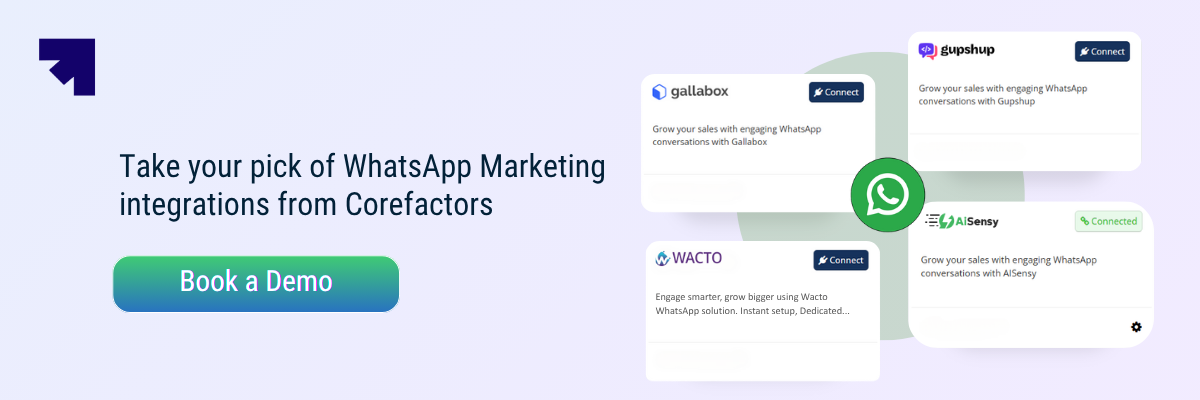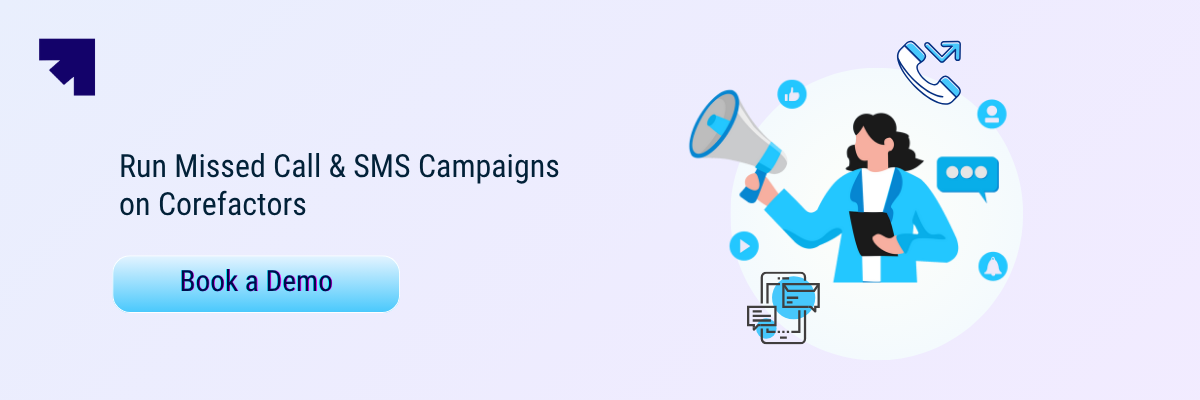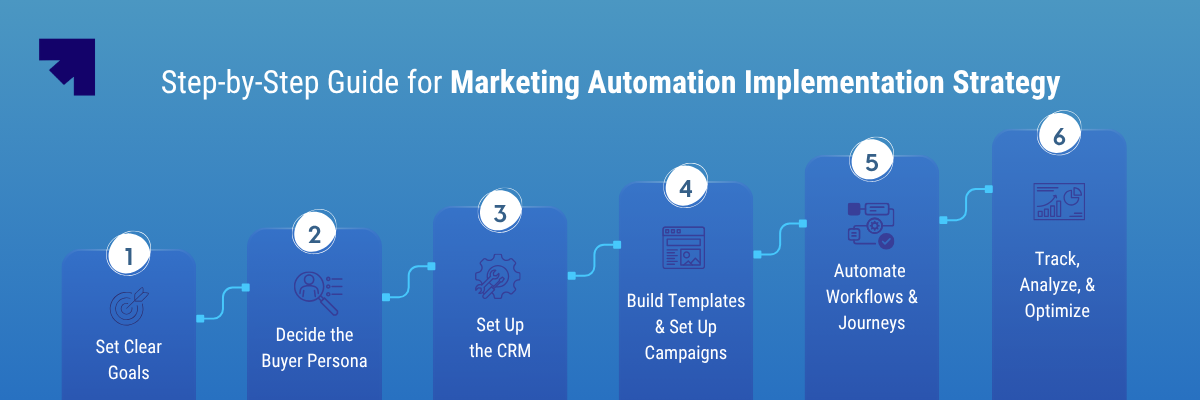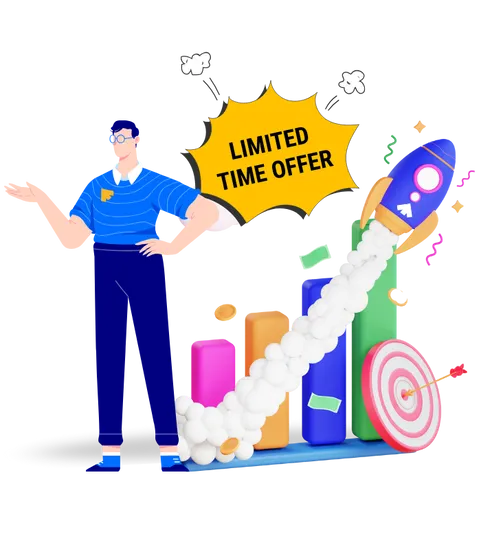Implementing Marketing Automation: A Step-by-Step Guide for Small Businesses

Heading 1
Heading 2
Heading 3
Heading 4
Heading 5
Heading 6
Lorem ipsum dolor sit amet, consectetur adipiscing elit, sed do eiusmod tempor incididunt ut labore et dolore magna aliqua. Ut enim ad minim veniam, quis nostrud exercitation ullamco laboris nisi ut aliquip ex ea commodo consequat. Duis aute irure dolor in reprehenderit in voluptate velit esse cillum dolore eu fugiat nulla pariatur.
Block quote
Ordered list
- Item 1
- Item 2
- Item 3
Unordered list
- Item A
- Item B
- Item C
Bold text
Emphasis
Superscript
Subscript
Implementing Marketing Automation: A Step-by-Step Guide for Small Businesses

N Suresh
Join us on November 6th as Mr. Yash Mishra, Product Manager, Fatakpay, reveals the precise strategies that eliminates the speed trap and guarantees a 30% conversion boost.
If you’re still chasing leads manually in 2025, you’re already losing ground to 91% of marketers who swear by marketing automation implementation to achieve their goals. That’s money and competitive edge slipping through the cracks every time you follow up late, segment poorly, or miss cross-channel opportunities. Marketing automation is now a structural upgrade for how modern businesses acquire, engage, and convert customers. And it’s reshaping the playing field faster than most realize.
While companies using automation gain clarity, consistency, and a measurable return on investment (ROI), many small businesses continue to operate in a reactive mode, unaware of how to transition or effectively leverage a small business marketing CRM. But those small businesses daring to invest in implementing automation have seen a 25% increase in marketing ROI.
Yet adoption remains patchy among them, not due to irrelevance, but complexity. Where to begin? What to automate? How to align it with existing workflows? If you are a small business, this blog will provide clarity on what you’ve been missing. It explores strategies to construct an intentional, data‑driven marketing system, leveraging effective marketing automation and its types of implementation through a small business marketing CRM that converts and scales on your terms, multiplying results while easing operational burdens.
What is Marketing Automation?
Marketing automation uses software to streamline and automate repetitive marketing tasks, such as email campaigns, social media posting, and lead nurturing, to improve efficiency and personalize customer interactions at scale.
Marketing automation implementation does not only mean scheduling emails or pushing messages. It is a system that reads behavior, makes decisions, triggers timely actions, and feeds your sales pipeline, while the team focuses on strategy instead of execution.
For small businesses, this means automating what used to be labor-intensive actions, such as capturing leads, qualifying them in your small business marketing CRM, and nurturing them across multiple touchpoints with email marketing, WhatsApp marketing automation, social media, and more.
What does marketing automation implementation look like in practice?
- A lead downloads an eBook. They’re instantly added to your CRM, receive a personalized welcome email, and are added to a lead-nurturing with marketing automation sequence.
- A customer abandons their cart. They get a WhatsApp reminder powered by the WhatsApp Business API, followed by a targeted offer email the next day.
- A purchase is made. A feedback request is sent, followed by a loyalty program campaign tailored to purchase behavior.
This is what workflow automation looks like when done right. It is predictive, adaptive, and seamlessly aligned with your larger digital marketing and marketing strategy. Whether you’re running inbound or outbound marketing, automation helps ensure every touchpoint is timely, relevant, and scalable.
Types of Marketing Automation
Modern marketing is a web of micro-interactions. Your automation stack should mirror that complexity, without making execution chaotic. Below are the key types of marketing automation that small businesses can deploy to scale smarter:
.png)
1. Email Marketing Automation
Emails are way smarter now with automated sequences that respond to user behaviour in real time. Email marketing is still the highest ROI channel in digital marketing, with a return of $36 for every dollar spent. Whether it’s onboarding a new lead or reactivating a dormant one, email marketing automation allows you to communicate with intent, along with the right timed frequency.
Think beyond newsletters and focus on:
- Welcome emails that introduce your brand and build trust
- Follow-up flows triggered by engagement or inactivity
- Promotional blasts personalized by product preferences
- Lead nurturing with marketing automation that maps content to the buyer’s journey
- Consistent, value-driven newsletters that position you as a thought leader
2. Social Media Marketing Automation
From scheduled content calendars to sentiment-aware response bots, social media marketing automation is the answer to maintaining presence without losing the human touch.
Social media automation helps you:
- Pre-schedule content across platforms with contextual timing
- Monitor brand mentions and keywords in real-time
- Auto-respond to frequently asked queries via DMs
- Gather behavioral insights for your cross-channel marketing
3. WhatsApp Marketing Automation
WhatsApp, with 2+ billion global users, has quietly evolved into one of the most powerful tools in the marketing ecosystem. For business, it can be a high revenue channel with WhatsApp Business API that can go beyond personal chats and drive hyper-targeted campaigns at scale.
WhatsApp automation is high-conversion, low-friction, and mobile-native, which can be perfect for today’s attention-deficit economy.
Using the WhatsApp Business API in a CRM, you can:
- Trigger welcome flows immediately after sign-up
- Send time-sensitive promotional offers
- Schedule transactional messages, such as order confirmations and payment links
- Automate festive and event-based campaigns
What sets WhatsApp automation apart is its immediacy, with open rates of 98% and unmatched intimacy. Business messaging platforms like WhatsApp are bringing about a revolution in customer satisfaction and customer retention.
WhatsApp has a conversion rate is 45 to 60%, i.e., out of every 100 users who receive a message, 45 to 60 click through and convert into customers.

4. Mobile Marketing Automation
Your customer’s phone is their second brain, their decision hub, and your brand needs a seat there. Mobile marketing automation makes sure you stay relevant in the palm of their hand, at the right time, in the right format.
Utilize the following:
- SMS campaigns with instant click-through CTAs
- RCS chats for higher engagement
- Geo-targeted push notifications
- Abandoned cart nudges
- Real-time updates for events or offers
Whether you’re sending a time-limited deal or a cart reminder, mobile marketing automation gives you speed, scale, and context on one platform without crossing the line of intrusion.

5. CRM Automation
CRM automation is where marketing strategy, execution, and performance converge. While emails nurture, WhatsApp engages, and SMS reminds, CRM automation ensures all these touchpoints speak to each other, orchestrating a seamless customer experience.
With CRM integrated marketing automation implementation, you can:
- Auto-capture and segment leads from every touchpoint, including email, WhatsApp, and landing pages
- Assign, score, and qualify leads in real-time without manual interference
- Build and trigger automation workflows based on lifecycle stages or engagement level
- Sync marketing and sales through a single dashboard, boosting RevOps efficiency
- Personalize campaigns with behavioral data directly from the CRM
- Improve lead nurturing with marketing automation that adapts to real-time signals
An intelligent small business marketing CRM stores data and unlocks data-driven insights to power every interaction. When integrated with tools like email marketing automation and WhatsApp automation, your CRM transcends simply serving as a database and becomes the source of truth for your cross-channel marketing strategy.
Platforms like Corefactors CRM unify this complexity, offering an end-to-end ecosystem where inbound and outbound marketing flows can be automated, optimized, and scaled from one place.
This is the future of operational excellence, and yes, it’s built on CRM automation.
Benefits of Marketing Automation Implementation for Small Businesses
For small businesses navigating resource constraints and market noise, the right marketing automation strategy can be transformative. Here are some benefits of marketing automation that help businesses move with precision, consistency, and scale:
- Less Effort, More Efficiency: Marketing automation implementation eliminates redundant manual tasks like campaign scheduling, list segmentation, or follow-up reminders.
- Cost-Effective at Scale: Marketing automation provides a 12.2% reduction in marketing overhead.
- Smarter Lead Generation and Nurturing: Using lead nurturing with marketing automation, small businesses can deploy dynamic workflows that adapt to user behavior in real time, warming up cold leads and accelerating those ready to convert without human intervention.
- Deeply Personalized Customer Experience: Using CRM integrated marketing automation or AI-driven segmentation, small businesses can now deliver hyper-personalized messages across email, SMS, and WhatsApp, without sounding robotic.
- Unified Branding Across Channels: Whether it’s a first-touch email or a last-mile WhatsApp nudge, automation ensures that your tone, visuals, and brand DNA remain consistent.
- Sales and Marketing Alignment via RevOps: A unified RevOps framework transforms marketing and sales from siloed functions into a cohesive, data-driven engine. Shared dashboards, automated lead routing, and synchronized goals eliminate ambiguit, and businesses with this model grew revenue 3X faster than those that didn’t.
- Data-Driven Insights for Better Decisions: Every automated campaign becomes a source of granular insight, like open rates, behavioral patterns, and conversion triggers that feed directly into your decision-making loop. With these real-time dashboards, numbers, and analytics, you're not guessing what works, but you're tracking it just on point.
- Predictable and Sustainable Revenue Growth
By automating customer journeys from discovery to loyalty, small businesses unlock predictable revenue growth, not from more hustle, but from smarter systems that compound over time.
Step-by-Step Guide for Marketing Automation Implementation Strategy
Marketing automation implementation goes beyond simply plugging in tools; it involves building a system that mirrors your customers’ journey and delivers value with precision. Here’s a strategic, scalable roadmap to implement it the right way:

Step 1: Set Clear Goals
Automation without clear objectives is just noise on autopilot. Define what you want to achieve; whether it's improving lead conversion, reducing churn, increasing email engagement, or boosting overall revenue growth. Your goal sets the foundation for your KPIs and tells your automation system what success actually looks like.
Example: Are you nurturing cold leads into booked demos? Or onboarding new users at scale? Each objective leads to a very different automation setup.
Step 2: Decide the Buyer Persona
Your automation is only as good as your understanding of who you’re targeting. Define your Ideal Customer Profile (ICP) and build detailed buyer personas based on demographics, pain points, behaviors, and motivations.
Different personas need different journeys. For instance, a founder focused on business growth typically values data-driven insights and ROI, while a marketer prioritizes flexibility and creative options. Personalization efforts should begin with these insights and not at the template stage.
Step 3: Set Up the CRM
Your CRM is the operational core of marketing automation implementation. Integrate all lead sources, such as landing pages, forms, ads, WhatsApp, and emails, so that new leads are automatically captured, segmented, and enriched in one place.
Map your customer journeys by defining stages
Example: New Lead → Engaged → Marketing Qualified Lead (MQL) → Sales Qualified Lead (SQL) → Won, and ensure the CRM reflects real-time interactions and funnel progress.
Ensure your CRM integrates seamlessly with your email marketing, WhatsApp Business API, and social tools to create a unified automation engine.
Step 4: Build Templates and Set Up Campaigns
Craft content that fits your brand’s tone and each persona’s context. Build template libraries across formats like email, WhatsApp, SMS, with dynamic placeholders for personalization (name, product, intent, etc.).
Maintain list hygiene through regular validation, segmentation, and cleansing to prevent deliverability problems and sustain engagement rates. Also, effective personalization extends beyond addressing recipients by name. It involves sending messages at optimal times, ensuring content relevance, and selecting the preferred communication channel.
Step 5: Automate Workflows and Journeys
Design workflows that reflect real behaviors and trigger-based actions. Example triggers include:
- Email open or click
- Abandoned cart
- No activity for X days
- Downloaded a lead magnet
- Webinar registration, but no attendance
Implement timed sequences that nurture prospects across multiple channels, such as a WhatsApp reminder followed by an email and an SMS nudge to guide them smoothly toward conversion.
Visual workflow builders in modern CRMs simplify design, enabling a focus on logical sequencing, timing, and emotional triggers.
Step 6: Track, Analyze, and Optimize
Marketing automation is a feedback loop. Regularly monitor campaign health using KPIs like:
- Open rate: The percentage of recipients who opened your email, indicating subject line effectiveness.
- Click-through rate (CTR): The percentage of recipients who clicked on a link within your email, showing content engagement.
- Bounce rate or Delivery rate: The percentage of emails that couldn't be delivered versus those successfully sent, reflecting list health.
- Unsubscribe rate: The percentage of recipients who opted out of your email list, suggesting content misalignment or frequency issues.
Run A/B testing on subject lines, sending times, call-to-action (CTA) placements, and channel strategies. Use these insights to iterate and improve, treating optimization as a continuous process rather than a one-time effort.
Marketing Automation Implementation Best Practices
Once your automation strategy is in motion, these core practices will help maximize performance with precision:
- Understand Your Audience: Define buyer personas using behavioral and intent data to create campaigns that resonate, not interrupt.
- Build a Clear Customer Journey: Map each stage from discovery to decision and deliver consistent, personalized, multi-channel marketing touchpoints.
- Segment and Personalize: Use dynamic segmentation to tailor content by behavior, preference, and funnel stage for maximum impact.
- Integrate with CRM for Real-Time Sync: Connect your CRM to sync lead data, enable lead scoring, and align sales-marketing via unified RevOps insights.
- Automate High-Impact, Low-Touch Workflows: Focus automation on lead nurturing, welcome flows, and social engagement to drive results at scale.
- Test Relentlessly, Optimize Continuously: Track key KPIs and run A/B tests frequently to refine what works and eliminate what doesn’t.
How to Choose a Marketing Automation Platform?
Not all automation platforms are created equal. The right tool for a small business should empower and not overwhelm. Here's what to evaluate when making your choice:
1. Email and Campaign Builder
Your platform should offer a visual, drag-and-drop email and campaign builder with options for triggered sequences, dynamic personalization, and list segmentation. Look for tools that allow A/B testing and real-time previews across devices to elevate your email marketing automation.
2. Landing Pages and Forms
Integrated landing page and form builders help capture leads directly from campaigns without relying on developers. Choose a platform that offers customizable templates, multi-step forms, and lead enrichment features, especially valuable for lead generation and nurturing efforts.
3. Comes with a CRM
Opt for a platform that includes or tightly integrates with a CRM for small businesses, ensuring a single source of truth across marketing and sales. This simplifies lead scoring, tracks customer journeys, and supports RevOps-aligned growth strategies.
4. Integrations
Your automation tool should plug effortlessly into your existing tech stack, such as your website, eCommerce platform, social media, WhatsApp API, and third-party CRMs. Robust marketing automation implementation ensures real-time sync and enables omnichannel marketing execution.
5. Rich Analytics
The platform should offer intuitive dashboards with metrics like open rate, CTR, conversion rate, and attribution tracking. Tools with real-time campaign analytics and reporting empower you to make smarter, faster decisions that are truly data-driven.
6. Cost
Look beyond the monthly fee, such as factoring in scalability, features offered at each tier, and hidden costs like contact limits or API access. For small businesses, a platform with low upfront investment but high automation potential is ideal for predictable revenue growth.
Also Read: Top Marketing Automation Software for Your Business
Automate Your Growth Journey
A robust marketing automation will be your productivity upgrade and also a strategic lever for small businesses to create meaningful customer journeys, align internal teams, and drive sustainable growth. When implemented right, it transforms your marketing from a series of disjointed efforts into a powerful, always-on ecosystem that delivers the right message to the right audience at the right time.
As we move deeper into the future of marketing automation, the focus will shift from basic task automation to predictive personalization, AI-powered decision-making, and unified customer experiences across every channel.
Whether you’re just beginning to automate or looking to optimize an existing setup, start with clear goals, choose the right tools, and continuously refine based on real insights with the right marketing automation for your business niche.
.png)
Heading 1
Heading 2
Heading 3
Heading 4
Heading 5
Heading 6
Lorem ipsum dolor sit amet, consectetur adipiscing elit, sed do eiusmod tempor incididunt ut labore et dolore magna aliqua. Ut enim ad minim veniam, quis nostrud exercitation ullamco laboris nisi ut aliquip ex ea commodo consequat. Duis aute irure dolor in reprehenderit in voluptate velit esse cillum dolore eu fugiat nulla pariatur.
Block quote
Ordered list
- Item 1
- Item 2
- Item 3
Unordered list
- Item A
- Item B
- Item C
Bold text
Emphasis
Superscript
Subscript
Frequently Asked Questions (FAQs)
What is marketing automation for small businesses?


Marketing automation for small businesses refers to using software to streamline marketing tasks like email campaigns, lead nurturing, and social media posting. It saves time, boosts efficiency, and drives personalized engagement with minimal manual input.
Why is marketing automation for small businesses important?


Marketing automation for small businesses enables lean teams to compete at scale. It helps deliver timely, relevant messaging, increases lead conversion, and supports consistent branding across channels.
How do I get started with marketing automation for small businesses?


Start by defining your goals, identifying your ideal customer, and choosing the right tools. Most platforms tailored to marketing automation for small businesses offer templates, integrations, and workflows to make onboarding easy.
What are the best tools offering marketing automation for small businesses?


Top platforms offering marketing automation for small businesses include Corefactors, Mailchimp, ActiveCampaign, Brevo, and HubSpot. Each offers unique features suited to different needs, from CRM integration to omnichannel messaging.
How does CRM integration enhance marketing automation for small businesses?


CRM integration brings real-time data syncing, lead scoring, and customer insights into your campaigns. It transforms marketing automation for small businesses into a full-funnel system that aligns sales and marketing efforts effectively.



















.png)




.png)